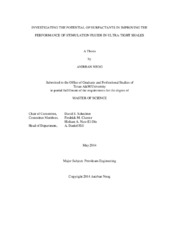| dc.contributor.advisor | Schechter, David S | |
| dc.creator | Neog, Anirban | |
| dc.date.accessioned | 2017-03-02T16:41:41Z | |
| dc.date.available | 2017-03-02T16:41:41Z | |
| dc.date.created | 2014-05 | |
| dc.date.issued | 2014-04-07 | |
| dc.date.submitted | May 2014 | |
| dc.identifier.uri | https://hdl.handle.net/1969.1/158900 | |
| dc.description.abstract | Commercial recovery of oil and gas from ultra-tight shale formations depends significantly on the performance of hydraulic fracturing. Enhancing the performance of the stimulation treatment can improve the estimated ultimate recovery of the well. This study investigates the potential of surfactants in enhancing the performance of hydraulic fracturing fluids by altering wettability and improving the process of spontaneous imbibition in oil rich shales demonstrating nanodarcy range permeability.
This study combines experimental work with numerical modeling and ties the lab findings to the wellhead performance in the field. A total of five different surfactants including nonionic and novel complex nano-surfactants were investigated in this study. Contact angle and interfacial tension measurements were performed at reservoir temperature to identify the state of native wettability and the impact of surfactants in altering wettability. Thereafter, spontaneous imbibition experiments were performed using computed tomography methods to understand the improvement in the magnitude of imbibition penetration due to surfactant addition. Overall, the complex nano-surfactants were more efficient in altering the wettability of the shale samples as compared to the nonionic surfactants. However, the results of the spontaneous imbibition experiments showed that one of the nonionic surfactants was just as effective in improving oil recovery as the complex nanosurfactants.
Core scale numerical modeling was performed to explain the experimental findings and the results of the core scale model were used in a single well frac model to investigate the impact of wettability alteration due to surfactant on well performance after hydraulic fracturing. It was observed that addition of surfactant to frac fluid lowers cumulative oil recovery due to the presence of additional capillary force resulting from a preferential state of wettability, which counteracts the viscous force created by the applied pressure drawdown.
The potential of surfactants in altering wettability in ultra-tight shales was verified in this study. Although wettability alteration during well stimulation was not found to be beneficial to the primary well performance, it might prove to be useful in other applications such as surfactant enhanced oil recovery in shales. | en |
| dc.format.mimetype | application/pdf | |
| dc.language.iso | en | |
| dc.subject | Shales | en |
| dc.subject | Enhanced Oil Recovery | en |
| dc.subject | Hydraulic Fracturing | en |
| dc.subject | Stimulation | en |
| dc.subject | CT methods, Wettability Alteration | en |
| dc.subject | Spontaneous Imbibition | en |
| dc.title | Investigating the Potential of Surfactants in Improving the Performance of Stimulation Fluids in Ultra-tight Shales | en |
| dc.type | Thesis | en |
| thesis.degree.department | Petroleum Engineering | en |
| thesis.degree.discipline | Petroleum Engineering | en |
| thesis.degree.grantor | Texas A & M University | en |
| thesis.degree.name | Master of Science | en |
| thesis.degree.level | Masters | en |
| dc.contributor.committeeMember | Chester, Fredrick M | |
| dc.contributor.committeeMember | Nasr-El-Din, Hisham A | |
| dc.type.material | text | en |
| dc.date.updated | 2017-03-02T16:41:41Z | |
| local.etdauthor.orcid | 0000-0002-1943-8550 | |


